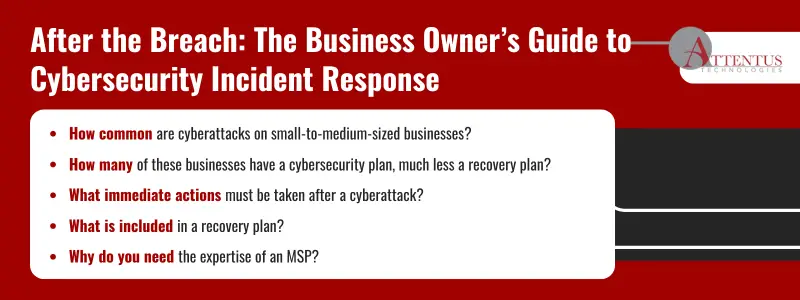No company is too large or too small to be a target. When attacked, how will you recover?

Hacking incidents are becoming more frequent, impacting businesses of all sizes—from small startups to large corporations. These breaches often result in the theft of sensitive data, financial losses, and reputational damage. The impact can be devastating for smaller businesses, potentially leading to closure, while larger entities may suffer hefty fines and loss of customer trust.
It’s an alarming fact that while 43% of cyberattacks target small- and medium-sized businesses, only 14% have a cybersecurity plan in place. These companies are ripe for attack by phishing, credential theft, and ransomware. As cybercriminals continue to develop more sophisticated tactics, it’s crucial that organizations have a solid response and recovery plan in place.
This guide will outline essential steps to take immediately after a cyber attack, including how to assess the extent of the breach, how to develop and execute a recovery plan for cybersecurity incident response, how to communicate a breach to those affected, and legal and regulatory requirements. You’ll also discover how partnering with an I.T. managed services provider (MSP) makes all the difference in your security posture.
Take These Immediate Actions After a Cyberattack
Experiencing a cyber attack is incredibly stressful, but taking swift and effective action mitigates damage. These steps will minimize the aftermath and strengthen your defenses for the future.
- Immediately isolate affected systems from the network. This can include disconnecting from Wi-Fi or unplugging Ethernet cables.
- Inform your internal IT team or MSP to begin the investigation process.
- Keep detailed records of the incident and any actions taken. This is crucial to understand the scope of the attack and inform the recovery process.
Assess the Extent of the Breach
When a security breach occurs, it’s crucial to quickly and effectively determine its scope, understand how it happened, assess its potential impacts, and take steps to mitigate future risks.
Partner with cybersecurity professionals for a thorough breach assessment. This will not only mitigate the immediate impacts but also strengthen your company’s security posture against future threats. This strategy ensures a comprehensive recovery plan is in place. A breach should assessment include:
1. Determine which systems and data were compromised
Start by listing all systems, networks, and devices that were involved in the breach. This could include servers, workstations, mobile devices, and cloud resources.
Next, identify the types of data accessed or stolen. This could include employee information, customer data, trade secrets, or financial records. The severity of the breach is gauged by how much data was compromised and the sensitivity of that data.
2. Identify how the breach occurred and which vulnerabilities were exploited
How did the attackers gain access? Through phishing, easy-to-guess passwords, unpatched software, or was a third-party service compromised? Document any specific misconfigurations or vulnerabilities.
Then, establish a timeline starting with the initial compromise through to detection. It’s important to understand how long the cybercriminals had access to identify the full scope of the breach.
3. Evaluate the potential impact
What is the potential impact, not only on business operations but also on customers and overall data privacy?
- Assess breach impact on operations: disruptions, costs, resources.
- Evaluate customer impact: trust loss, identity theft, data exposure.
- Understand compliance and legal implications of the breach.
4. Partner with cybersecurity professionals for a thorough assessment
Don’t go it alone. MSP cybersecurity professionals have the expertise to assess breaches and identify overlooked signs. They conduct forensic analysis, document incidents for legal and compliance needs, and recommend tailored security measures and best practices.
Then, Develop and Execute a Robust Recovery Plan
A strong cyberattack response plan is essential to restore systems and secure against future threats. Effective recovery helps your business bounce back and prepares for future attacks. This involves a layered approach: fixing vulnerabilities, strengthening security, and continuous monitoring to detect and handle threats. It’s a complex task best handled by experts.
Restore data from backups
- Verify the integrity and security of your backups – ensure that the backups themselves.
- Perform a clean installation. Before restoring data, reformat the affected systems and reinstall operating systems to remove any residues of malware or ransomware.
- Restore data to a separate, secure environment to verify integrity and functionality. This step ensures that the restored data is not carrying any threats.
- Reconfigure the systems with the proper settings, firewall rules, and access controls before reconnecting them to the network.
- Test the restored systems to ensure they operate as intended without issues.
Address vulnerabilities
- Update all operating systems, software, and firmware on devices to the latest versions.
- Enforce a strong password policy. Require all users to change their passwords post-incident and implement multi-factor authentication.
- Apply all the necessary security patches released by your software and hardware vendors.
- Conduct a thorough network audit to identify the entry points of the attack. Review system logs and identify unusual activities that went unnoticed.
- Train staff to recognize and avoid phishing attacks and stop unsafe practices.
Continuously monitor
- Use intrusion detection systems, antivirus programs, and network monitoring tools. Continuously scan for suspicious activity.
- Schedule regular security audits and vulnerability scans to proactively identify and remediate security weaknesses.
- Update the incident response plan based on what was learned from the current attack. Detail steps for containment, eradication, recovery, and lessons learned.
- Set up alerts for unusual access patterns or unauthorized data exports that could indicate a persistent threat or a breach attempt.
- Create a feedback mechanism so employees can report anomalies, regularly review these inputs, and adjust security measures as needed.
Communicate with stakeholders and authorities
Clear communication with stakeholders and authorities after a breach is vital for compliance, mitigation, and preserving trust. Address the issue openly with transparent, consistent, and legally aware messaging to minimize damage to your company’s reputation and relationships.
Inform customers quickly so they can take protective measures, like changing passwords and monitoring for unusual activity.
Keep employees informed to help prevent further issues and guide them on external communications.
Notify affected vendors promptly to secure their systems and maintain supply chain integrity. While transparency is key, carefully manage the narrative to highlight your proactive steps and consider enlisting a public relations expert to help.
Legal reporting requirements
In the United States, the legal requirements for reporting a data breach to authorities and regulatory bodies vary depending on the sector, the nature and size of the breach, and state laws. Here’s a general overview:
Federal laws that apply include:
- HIPAA (Health Insurance Portability and Accountability Act) For organizations handling protected health information, HIPAA requires covered entities and their business associates to notify the Department of Health and Human Services (HHS), affected individuals, and, in some cases, the media of a breach of unsecured personal health information. Notifications to individuals must be sent no later than 60 days following the discovery of a breach.
- The Gramm-Leach-Bliley Act applies to financial institutions and requires them to protect the security and confidentiality of consumers’ “nonpublic personal information.” In the event of a data breach, financial institutions are required to notify affected individuals if misuse of the information has occurred or is reasonably possible.
When it comes to state laws, Nearly all U.S. states have enacted data breach notification laws that require businesses to notify consumers if their personal information has been compromised in a data breach. The specifics of these laws, including what triggers notification and timing, vary by state.
Also, in certain cases, particularly where a large number of individuals are affected, businesses may be required to notify the major credit reporting agencies.
Don’t Be a Sitting Duck for Cybercriminals
The rise in hacking incidents highlights the urgent need for strong cybersecurity and recovery plans for businesses of all sizes, especially smaller ones, which often lack adequate measures. A solid response plan includes isolating affected systems, communicating with stakeholders, and meeting legal requirements to minimize damage and strengthen defenses. Partnering with an MSP ensures effective incident response and a tailored recovery plan. Combining strategic planning with expert guidance helps protect an organization’s assets and reputation.
At Attentus, we provide tailored solutions to protect your business and help you recover from attacks with minimal disruption. With over 20 years of cybersecurity expertise, we ensure your organization is safeguarded against current and future threats. We are committed to delivering exceptional results—one of our core values—by ensuring every aspect of your cybersecurity strategy is meticulously crafted to meet your unique needs. We invite you to contact us to develop a robust cyber attack response plan with our ongoing support, ensuring your business remains secure and resilient. Stay proactive and safeguarded with Attentus by your side.
